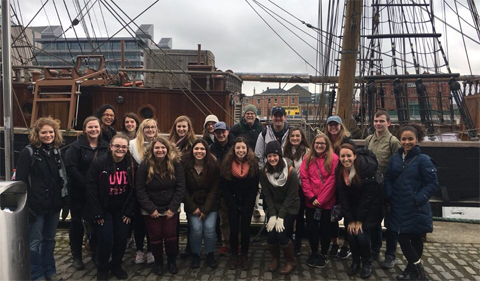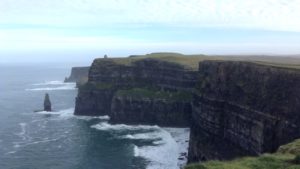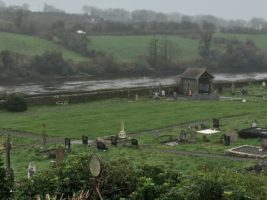
OHIO students in front of the gateway to University College Cork
By Matt McCullough ’17
Eighteen Ohio University students spent their spring break in the Republic of Ireland as part of the Ireland: Food, Hunger, and Inequality study abroad program, now in its second year.
Ireland as an Educational Opportunity
The Ireland program is offered through the Sociology & Anthropology Department. The course that accompanies the trip to Ireland, Writing in Sociology & Anthropology (SOC 3560j), satisfies the university-wide junior-level composition requirement.
This course is the most popular option, but students can also select Special Topics in Sociology (SOC 2900). Whichever option students choose, they do the same work and all receive four credit hours.
The theme of “food, hunger, and inequality” comes from the interest of the program director, Dr. Stephen Scanlan, Associate Professor of Sociology. Scanlan specializes in inequality, development, social change, and environmental sociology.
“The theme involves food studies, wealth and poverty, as well as a little bit of sustainability,” says Scanlan. “Students are attracted to the freedom and flexibility of the subject as well as the contribution to Jcom.”
The course itself involves sociological writing assignments, including a book review, on-site field notes, reflection essays, and a research paper, which are all done throughout the semester. The course does not meet on a weekly basis.

OHIO students in front of the Jeanie Johnston Famine Ship in Dublin, Ireland
Why Ireland?
Scanlan says that the inspiration to take students to Ireland stems from his research sabbatical with the Fulbright Scholar Program. With expertise in food insecurity, Scanlan knew “I would want to return and take students with me.”
The theme “food, hunger, and inequality” is a contemporary topic that applies all over the globe. For Ireland, Scanlan decided to use the Great Irish Famine as a historical point of departure and backdrop for the course theme.
Ellie Koewler, the program’s On-site Program Coordinator, worked with Scanlan to implement this program through the Office of Global Opportunities.
Koewler says she was interested in being the coordinator because of “having worked closely with the program director, Dr. Scanlan, as the program was first developed and marketed.”
In sum, students spend one week abroad in Ireland visiting sites and gaining experiences both related to food as well as the Great Irish famine. Then, students produce written assignments synthesizing that knowledge for credit.
Overall, this program provides a unique learning opportunity with many wonderful experiences abroad.

OHIO students touring an Irish workhouse in Portumna
Food and Famine Excursions Abroad
One week abroad is a short amount of time for a program, so the week is an intense itinerary of site visits and traveling.
The first day included a walking tour of the city of Dublin, as well as a stop at the Jeanie Johnston famine ship, and a welcome dinner at The Brazen Head.
The next day students bused to the southern coast to the city of Cork for a walking tour of Cork’s food scene, including the Quay Co-op, English Market, and Butter Museum. The day ended with a lecture from Dr. Mike Murphy at the University College Cork.
Murphy is the co-editor of the Atlas of the Great Irish Famine, and gave a lecture on the demographic and geographic considerations to the famine, including food availability, housing, mortality and workhouse locations.
The next day featured another UCC lecture from Dr. Larry Geary. A historian, Geary lectured on the political, economic, and cultural relations and the challenge they presented in the famine.
Afterward, a bus ride to the town of Skibbereen to visit the Heritage Center and famine graveyard. Lastly, students visited Gort Na Nain farm before heading back to Cork.
The next day, students set off to the seaside village of Doolin, stopping at Killarney National Park along the way.
The next morning, students visited the beautiful Cliffs of Moher, then cruised along the Wild Atlantic Way to Hazel Mountain Chocolate Factory. The day ended with a brief stop at the Famine Ship Memorial in Celia Griffin Memorial Park in Galway City.

Cliffs of Moher, Ireland
The next day brought the students to Strokestown Park and the Irish National Famine Museum. After returning to Galway, students had a heart-warming farewell dinner at McCambridge’s.
The final day involved a drive from Ireland’s west coast all the way back to Dublin, stopping at an Irish workhouse for a couple of lectures and a guided tour in Portumna. Students then had the next couple of days to return home.
Reflections on a Trip of a Lifetime
Studying abroad is an experience not everyone takes advantage of, but those who did will tell you how much it is worth doing.
Jessica Smith, a junior studying communications, said the Ireland program appealed to her because “I’ve never traveled much before without my family. I get homesick really easily so I wanted something short that filled my major requirements.
“I’m so happy I did it!” she adds. “It was an experience of a lifetime, and I’m already looking at other study abroad programs.
“You learn a lot about the people and their views on the U.S. It’s interesting learning about other cultures.”
Smith says her favorite part included the breath-taking Cliffs of Moher and “trying new foods and drinks. We had a ton of opportunities with this trip specifically to do this because of how many of our meals were paid for. I think it really broadened everyone’s taste buds.”
Alex Stewart, a junior studying marketing, said the program interested her because “it was during a time I was available to travel, and it was a program far outside of my major.
“It reignited my passion for art and gave me the chance to make new friends,” she added. “As an extrovert, I love the challenge of making friends with strangers. Meeting people from all over the world was also an added bonus.”

Ross Castle in Killarney National Park, Ireland
Koewler says she loves the program because it “reaches corners of Ireland that most people would not see as tourists. I also enjoy visiting the smaller sites and museums run by local historians and organizations.
“It’s great to support community-based tourism when possible. I always enjoy Ireland any chance I get to visit – the stunning landscape and delicious food are also incredible!”

The empty patch of grass in Skibbereen marks the gravesite of hundreds of famine victims.
Finally, what Scanlan says he enjoys most about the program is “watching the students engage with the culture and seeing their reactions. They’re learning but having fun while they converse with the people.”
Want to be a Part of this Program?
To apply next year, keep an eye on the Office of Global Opportunities’ page for Ireland: Food, Hunger, and Inequality. Applications open in September.
Other study abroad programs can be browsed here as well, providing more logistical information on each program.
Studying abroad is a wonderful experience that gives unique learning opportunities and lasting memories. Every student should consider studying abroad.

















One Comment